Abstract
1 Twitch responses of the guinea-pig ileum to electrical transmural stimulation (0.2 Hz) were smaller after a dose of acetylcholine (ACh) than before it. The magnitude of the post-ACh inhibition of twitch was dose-dependent. 2 The post-ACh inhibition of twitch could not be explained in terms of post-junctional desensitization and was not modified by guanethidine, thymoxamine, propranolol or naloxone. Inhibition of twitch also followed high frequency stimulation (10 Hz) but this inhibition, unlike that following ACh, was partially antagonized by naloxone. 3 Hexamethonium (C6) in concentrations known to block contractions to nicotine, potentiated the post-ACh inhibition of twitch and modified the pattern of recovery. An initial rapid phase followed by a slower phase was converted by C6 to an initial slow phase followed by a more rapid rate of recovery. 4 The C6-sensitive (nicotinic) component of twitch recovery after ACh was also dose-dependent and contributed greatly to the rapid recovery during the first minute after ACh washout, whereas during the same period the C6-resistant inhibition remained relatively constant; thereafter both components declined. The C6-resistant inhibition was considered to be due to the activation of prejunctional muscarinic receptors. 5 5-Hydroxytryptamine (5-HT) and nicotine also caused inhibition of twitch but the pattern of response differed from those due to ACh, the maximum inhibition usually being produced 1 min after recommencing stimulation. High doses of 5-HT produced inhibitory responses similar to those following ACh, whereas nicotine produced a characteristic triphasic pattern of response. 6 It is concluded that ACh acts on at least two prejunctional receptors subserving a modulatory role on transmitter release, a nicotinic receptor whose activation enhances ACh output and a muscarinic receptor whose activation leads to an inhibition of transmitter secretion.
Full text
PDF
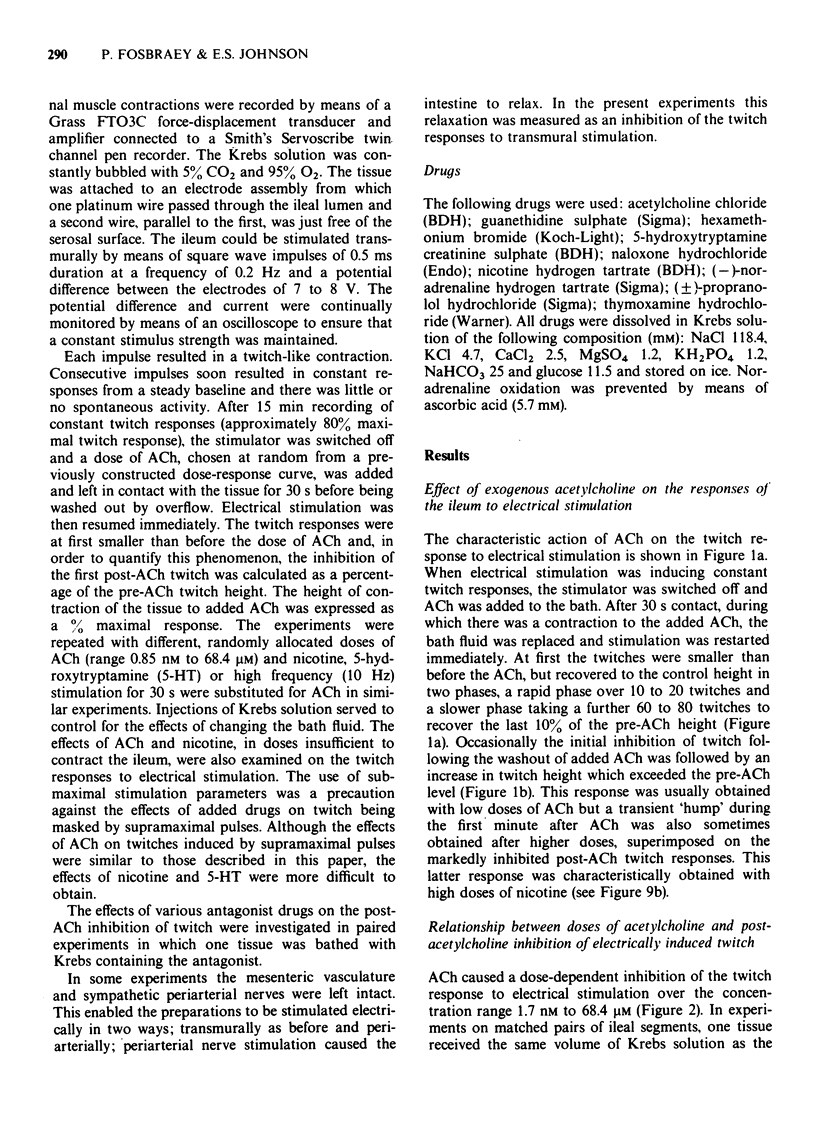
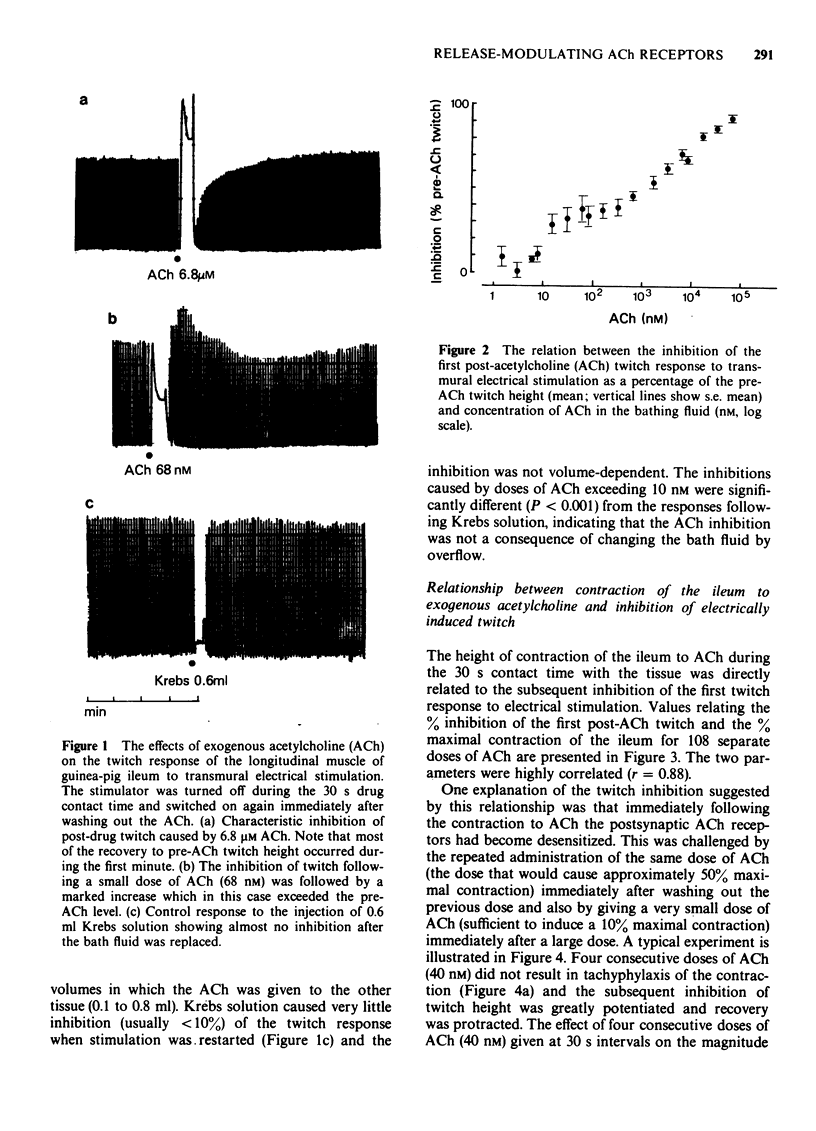
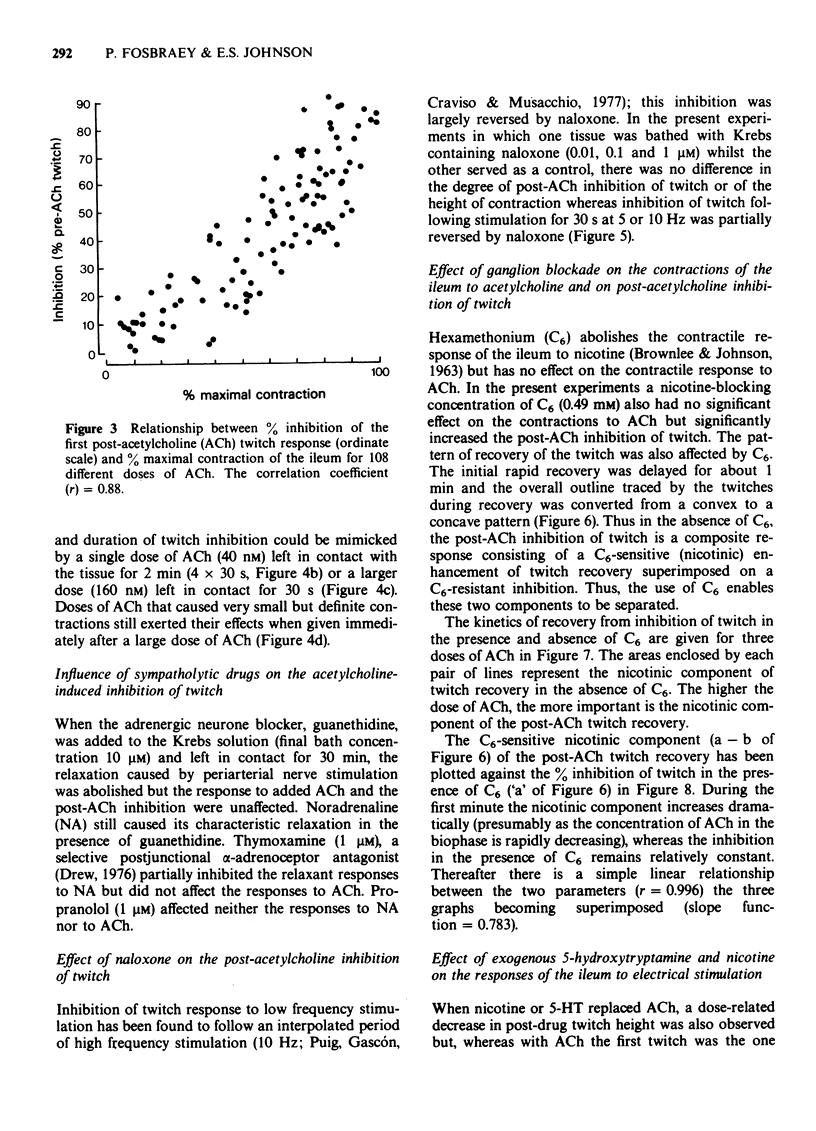
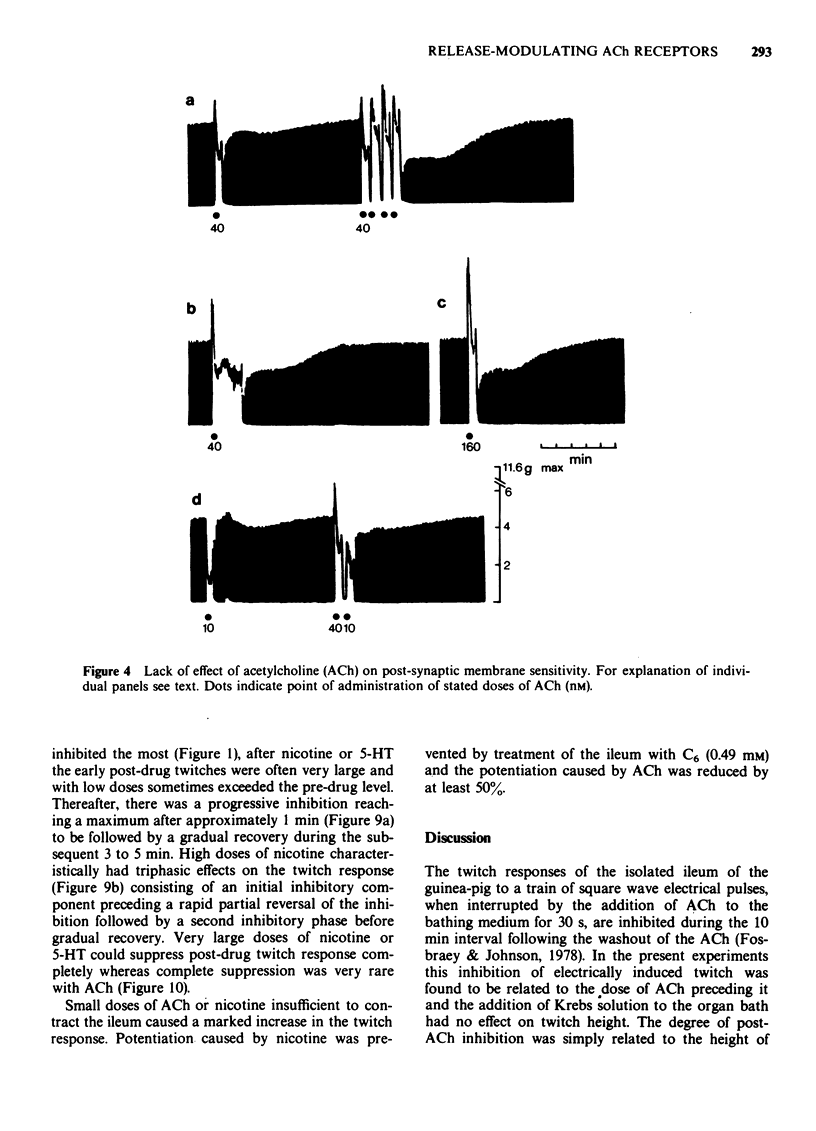
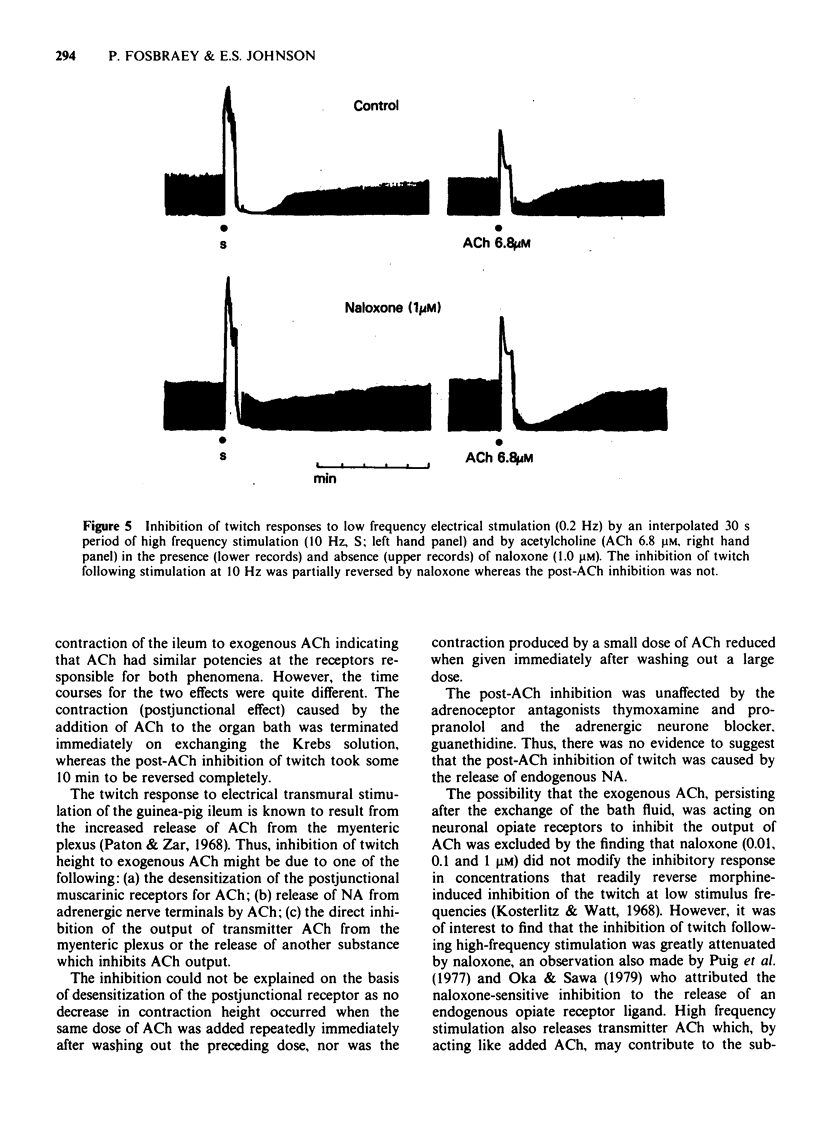
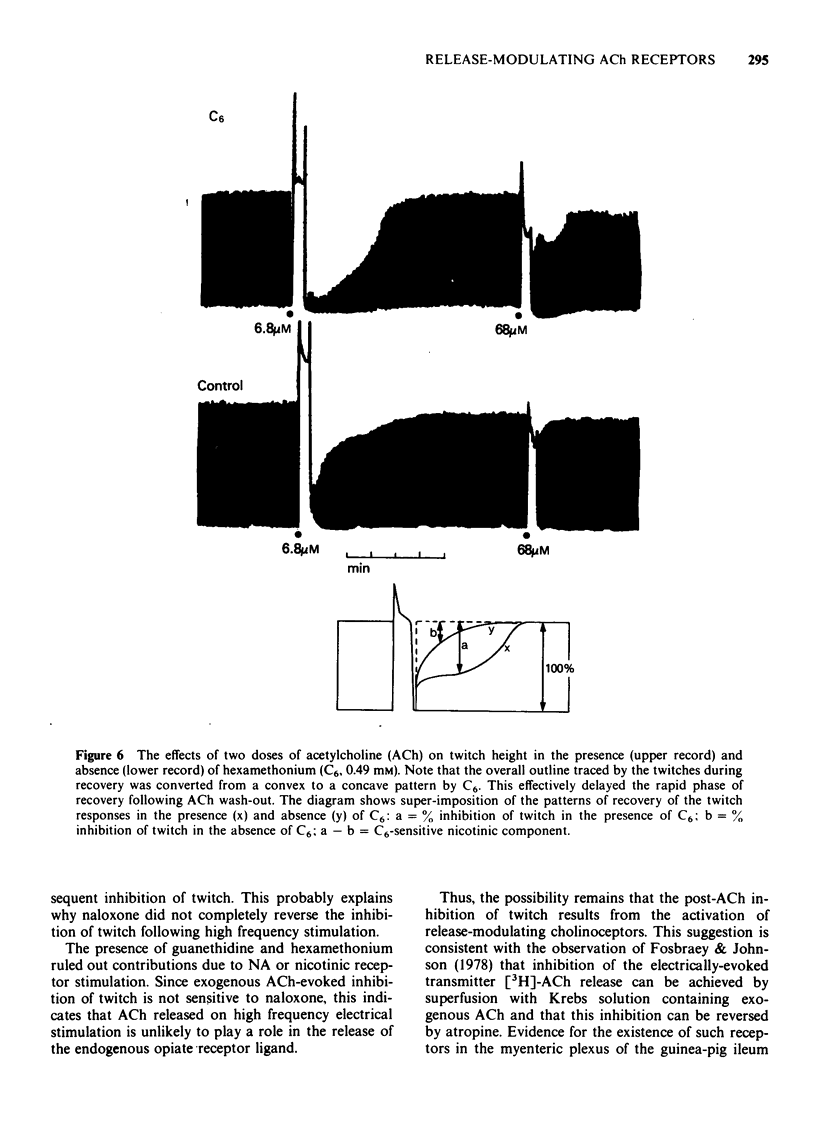
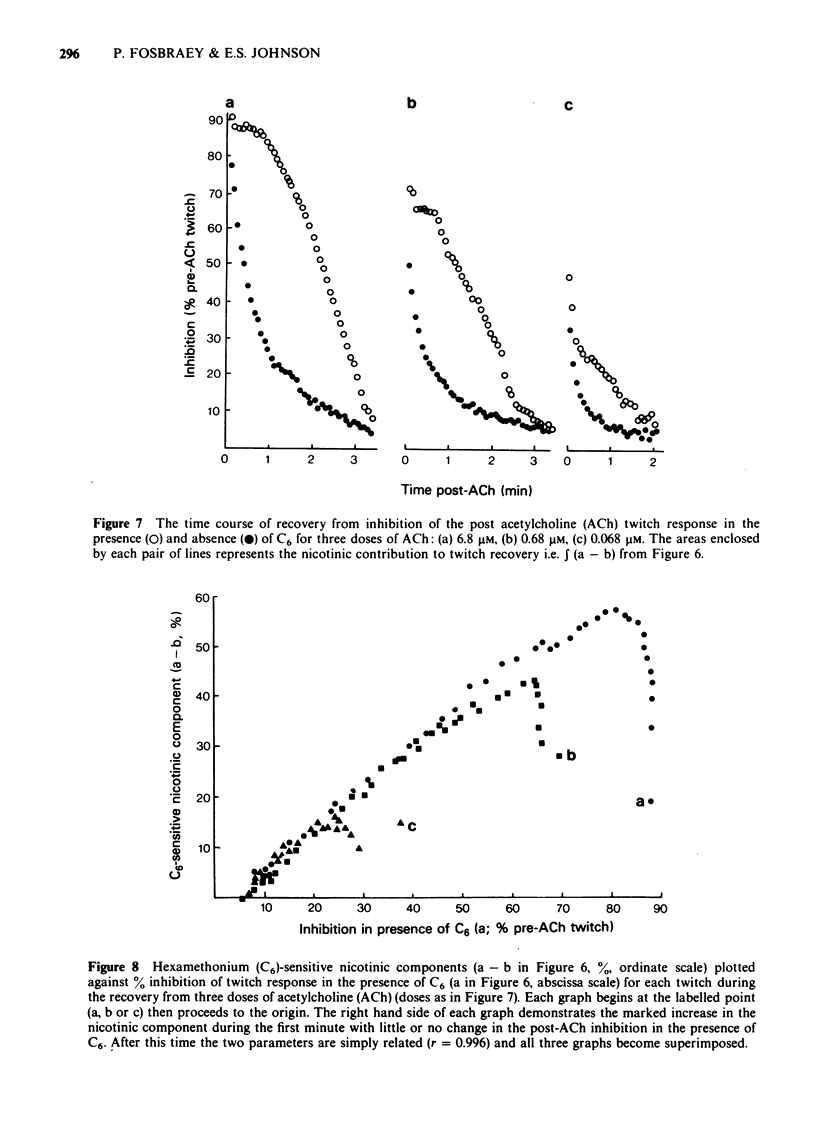
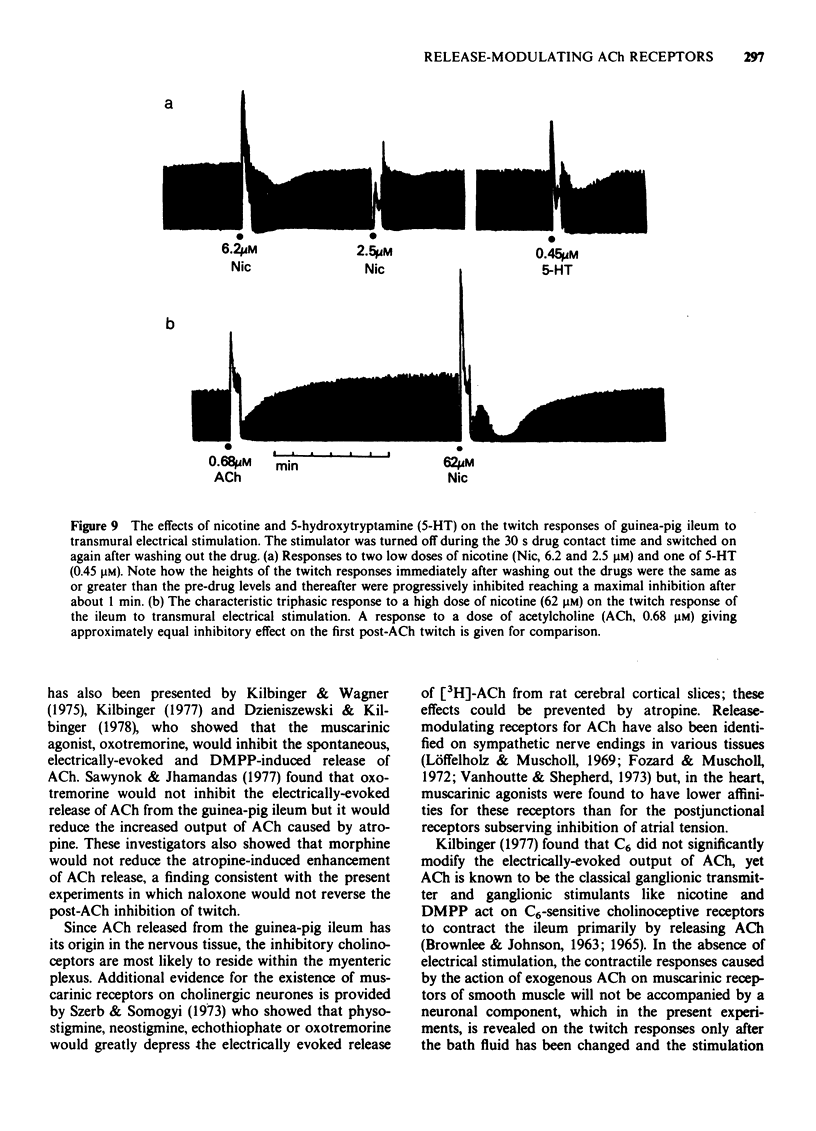
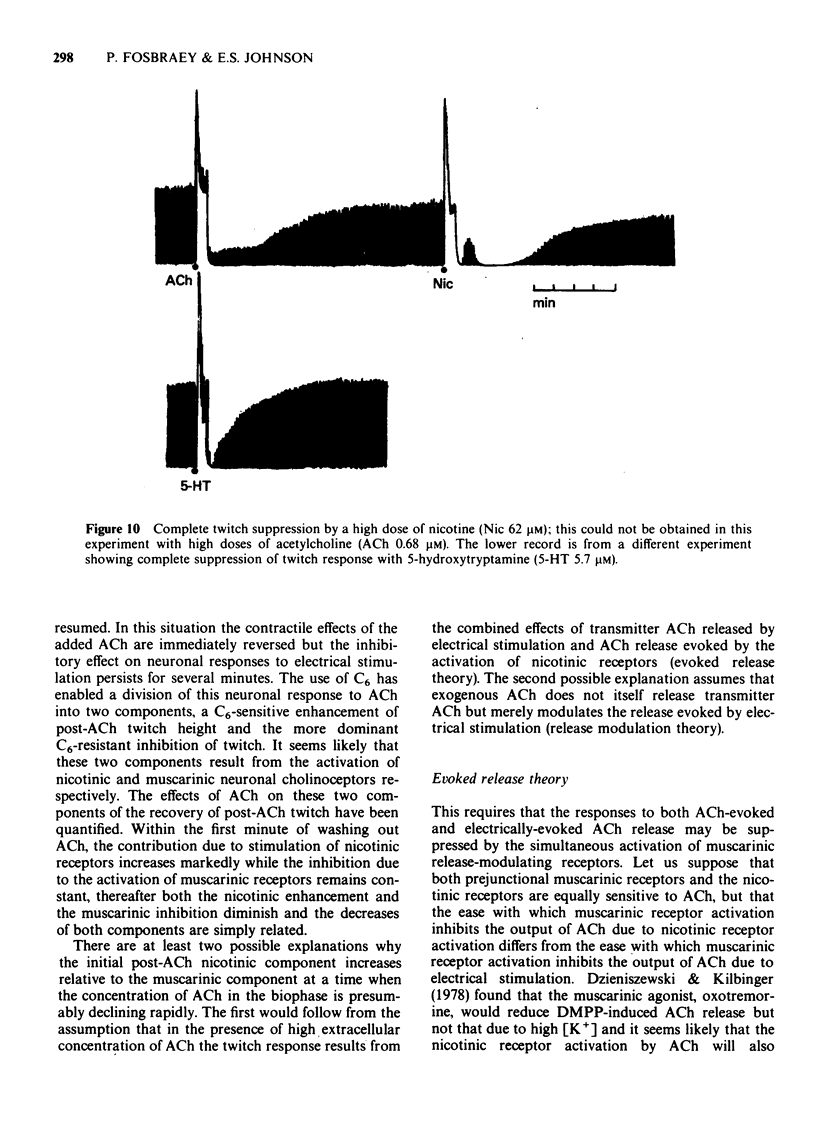
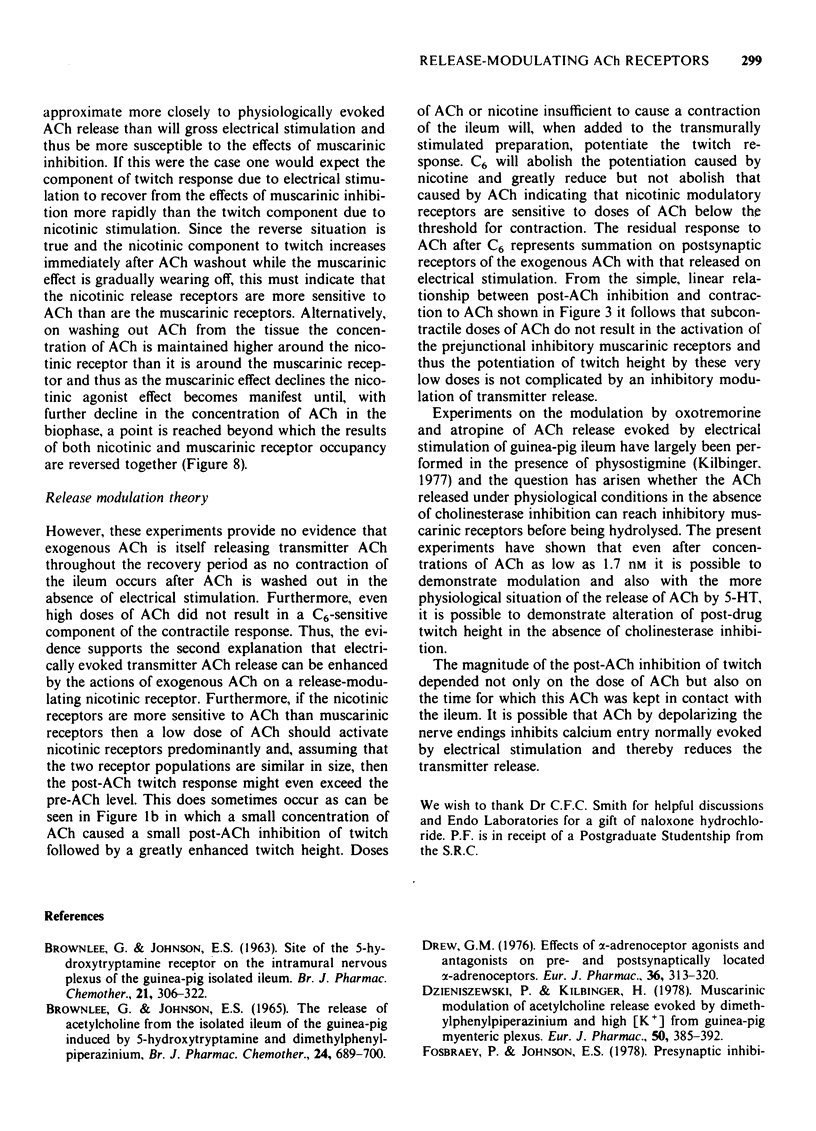
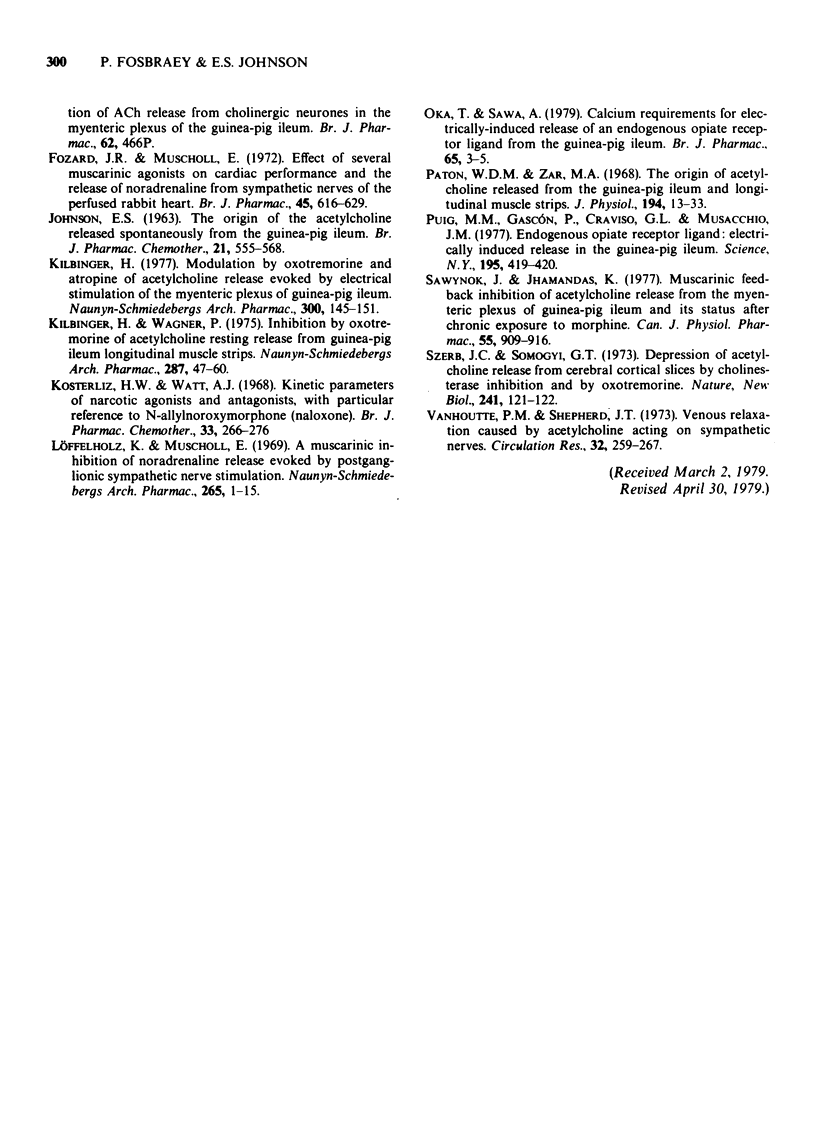
Selected References
These references are in PubMed. This may not be the complete list of references from this article.
- BROWNLEE G., JOHNSON E. S. THE RELEASE OF ACETYLCHOLINE FROM THE ISOLATED ILEUM OF THE GUINEA-PIG INDUCED BY 5-HYDROXYTRYPTAMINE AND DIMETHYLPHENYLPIPERAZINIUM. Br J Pharmacol Chemother. 1965 Jun;24:689–700. doi: 10.1111/j.1476-5381.1965.tb01624.x. [DOI] [PMC free article] [PubMed] [Google Scholar]
- BROWNLEE G., JOHNSON E. S. THE SITE OF THE 5-HYDROXYTRYPTAMINE RECEPTOR ON THE INTRAMURAL NERVOUS PLEXUS OF THE GUINEA-PIG ISOLATED ILEUM. Br J Pharmacol Chemother. 1963 Oct;21:306–322. doi: 10.1111/j.1476-5381.1963.tb01529.x. [DOI] [PMC free article] [PubMed] [Google Scholar]
- Drew G. M. Effects of alpha-adrenoceptor agonists and antagonists on pre- and postsynaptically located alpha-adrenoceptors. Eur J Pharmacol. 1976 Apr;36(2):313–320. doi: 10.1016/0014-2999(76)90084-4. [DOI] [PubMed] [Google Scholar]
- Dzieniszewski P., Kilbinger H. Muscarinic modulation of acetylcholine release evoked by dimethylphenylpiperazinium and high potassium from guinea-pig myenteric plexus. Eur J Pharmacol. 1978 Aug 15;50(4):385–391. doi: 10.1016/0014-2999(78)90144-9. [DOI] [PubMed] [Google Scholar]
- Fosbraey P., Johnson E. S. Presynaptic inhibition of acetylcholine release from cholinergic neurones in the myenteric plexus of the guinea-pig ileum [proceedings]. Br J Pharmacol. 1978 Mar;62(3):466P–466P. [PMC free article] [PubMed] [Google Scholar]
- Fozard J. R., Muscholl E. Effects of several muscarinic agonists on cardiac performance and the release of noradrenaline from sympathetic nerves of the perfused rabbit heart. Br J Pharmacol. 1972 Aug;45(4):616–629. doi: 10.1111/j.1476-5381.1972.tb08119.x. [DOI] [PMC free article] [PubMed] [Google Scholar]
- JOHNSON E. S. THE ORIGIN OF THE ACETYLCHOLINE RELEASED SPONTANEOUSLY FROM THE GUINEA-PIG ISOLATED ILEUM. Br J Pharmacol Chemother. 1963 Dec;21:555–568. doi: 10.1111/j.1476-5381.1963.tb02023.x. [DOI] [PMC free article] [PubMed] [Google Scholar]
- Kilbinger H. Modulation by oxotremorine and atropine of acetylcholine release evoked by electrical stimulation of the myenteric plexus of the guinea-pig ileum. Naunyn Schmiedebergs Arch Pharmacol. 1977 Nov;300(2):145–151. doi: 10.1007/BF00505045. [DOI] [PubMed] [Google Scholar]
- Kilbinger H., Wagner P. Inhibition by oxotremorine of acetylcholine resting release from guinea pig-ileum longitudinal muscle strips. Naunyn Schmiedebergs Arch Pharmacol. 1975;287(1):47–60. doi: 10.1007/BF00632637. [DOI] [PubMed] [Google Scholar]
- Kosterlitz H. W., Watt A. J. Kinetic parameters of narcotic agonists and antagonists, with particular reference to N-allylnoroxymorphone (naloxone). Br J Pharmacol Chemother. 1968 Jun;33(2):266–276. doi: 10.1111/j.1476-5381.1968.tb00988.x. [DOI] [PMC free article] [PubMed] [Google Scholar]
- Löffelholz K., Muscholl E. A muscarinic inhibition of the noradrenaline release evoked by postganglionic sympathetic nerve stimulation. Naunyn Schmiedebergs Arch Pharmakol. 1969;265(1):1–15. doi: 10.1007/BF01417206. [DOI] [PubMed] [Google Scholar]
- Paton W. D., Zar M. A. The origin of acetylcholine released from guinea-pig intestine and longitudinal muscle strips. J Physiol. 1968 Jan;194(1):13–33. doi: 10.1113/jphysiol.1968.sp008392. [DOI] [PMC free article] [PubMed] [Google Scholar]
- Puig M. M., Gascon P., Craviso G. L., Musacchio J. M. Endogenous opiate receptor ligand: electrically induced release in the guinea pig ileum. Science. 1977 Jan 28;195(4276):419–420. doi: 10.1126/science.188138. [DOI] [PubMed] [Google Scholar]
- Sawynok J., Jhamandas K. Muscarinic feedback inhibition of acetylcholine release from the myenteric plexus in the quinea pig ileum and its status after chronic exposure to morphine. Can J Physiol Pharmacol. 1977 Aug;55(4):909–916. doi: 10.1139/y77-121. [DOI] [PubMed] [Google Scholar]
- Szerb J. C., Somogyi G. T. Depression of acetylcholine release from cerebral cortical slices by cholinesterase inhibition and by oxotremorine. Nat New Biol. 1973 Jan 24;241(108):121–122. doi: 10.1038/newbio241121a0. [DOI] [PubMed] [Google Scholar]
- Vanhoutte P. M., Shepherd J. T. Venous relaxation caused by acetylcholine acting on the sympathetic nerves. Circ Res. 1973 Feb;32(2):259–267. doi: 10.1161/01.res.32.2.259. [DOI] [PubMed] [Google Scholar]


